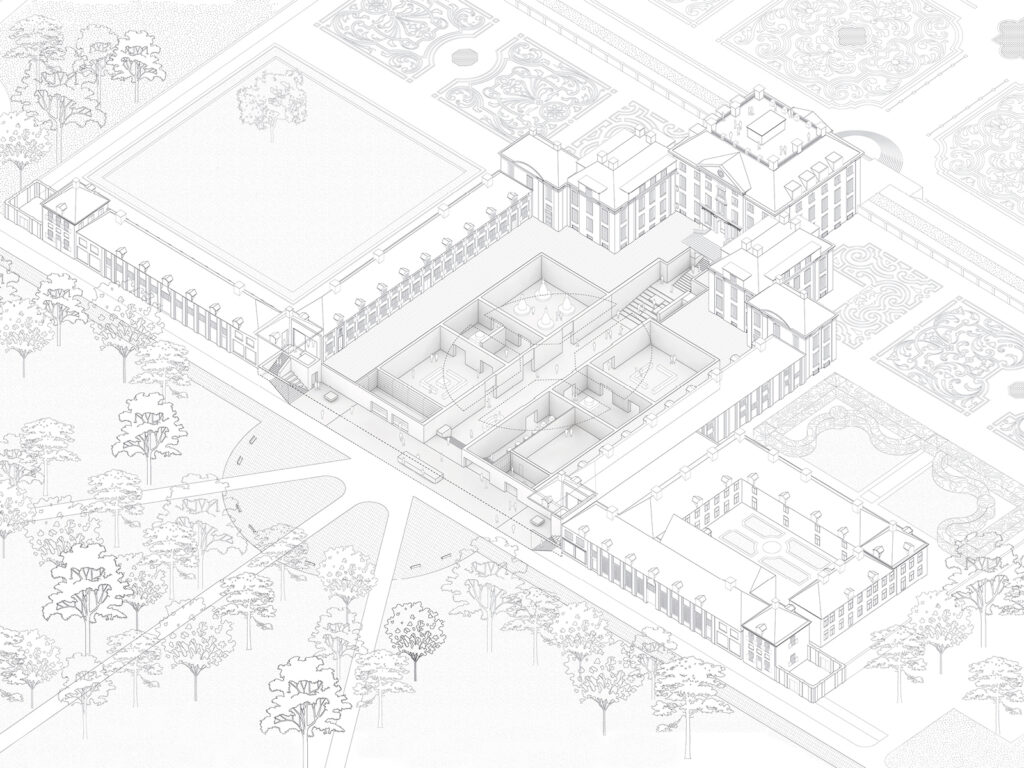The historic Paleis Het Loo, a baroque hunting palace on the outskirts of Apeldoorn, has recently undergone an ambitious and meticulous transformation that seamlessly blends its historical features with modern exhibitions and is set to open next week.

The project involved:
- The addition of over 5,000 square meters of new facilities and spaces
- Careful restoration of the palace
- An extensive asbestos removal process
The result is a revitalized cultural attraction that offers a space for reflection on the monarchy’s role in Dutch history while showcasing the remarkable engineering behind the renovation and a modern engineering marvel.
Paleis Het Loo – An Engineering Marvel
One of the most impressive aspects of the Paleis Het Loo renovation is the innovative placement of the new extension directly underneath the historic courtyard, designed by Dutch architect Dikkie Scipio of KAAN Architects. This underground expansion maintains the palace’s original view from 350 years ago and integrates modern facilities without disrupting the site’s historical integrity.

The engineering team faced considerable challenges in digging a 10-meter-deep basement, pumping out 35,000 cubic meters of water, and removing 1,800 trucks of sand. As the team worked on this, they had to lift the onto temporary foundations. Despite the complexity, the result is a stunning and innovative space that offers visitors a unique experience of the past and present.
The Bassecour courtyard has become a mesmerizing space with a central fountain, glass surfaces adorned with natural stone, and flowing water reminiscent of the historic gardens. The shallow ponds serve as the roof of the new extension and reflect the palace, allowing daylight to filter through and create a stunning effect.

The new facilities include:
- Exhibition halls.
- A museum for children.
- A permanent exhibition on the history of the Dutch royal family.
The Grand Foyer serves as the extension’s central hub and maintains the baroque composition’s symmetry. A glass roof visually connects the foyer to the historic building, emphasizing the seamless integration of old and new.
Meticulous Restoration and Attention to Detail
As part of the renovation, the historic palace underwent careful restoration to improve technology and climate control systems.
The finishes in the new building are elegant and restrained, with textures and materials blending harmoniously. Walnut wood, marble with alternating sandblasted, honed, and polished surfaces, and opulent fabrics with metallic threads are used throughout, referencing the gardens and the ornate halls of the original palace.

The revitalized Paleis Het Loo is a testament to the exceptional engineering and attention to detail that went into its renovation. The seamless blend of historical features and modern exhibitions creates a fascinating and immersive experience for visitors. This ambitious project has successfully transformed Paleis Het Loo into a cultural attraction that encourages reflection on the monarchy’s role in Dutch history while celebrating the engineering marvels behind its restoration.
The architecture firm responsible for the Paleis Het Loo renovation project is KAAN Architecten, led by Dutch architect Dikkie Scipio. Known for developing innovative designs that acknowledge historical context and prioritize environmental sustainability, KAAN Architecten has completed various European projects. For Paleis Het Loo, the firm showcased its ability to integrate modern and traditional elements, respecting the palace’s significant heritage. The underground extension, which thoughtfully combines contemporary design with historical features, demonstrates the firm’s dedication to quality and skill in revitalizing an important cultural site.
The new museum will open its doors next week.
TLDR
- Paleis Het Loo, a baroque hunting palace in Apeldoorn, underwent a meticulous renovation to blend historical features with modern exhibitions.
- The project included the addition of over 5,000 square meters of new facilities, careful restoration of the palace, and an extensive asbestos removal process.
- One of the most impressive aspects of the renovation is the innovative placement of the new extension directly underneath the historic courtyard.
- The new facilities include exhibition halls, a museum for children, and a permanent exhibition on the history of the Dutch royal family.
- The revitalized Paleis Het Loo offers a space for reflection on the monarchy’s role in Dutch history while showcasing exceptional engineering and attention to detail.
- The architecture firm responsible for the project is KAAN Architecten, known for innovative designs that prioritize historical context and environmental sustainability.
- The new museum will open its doors next week.








